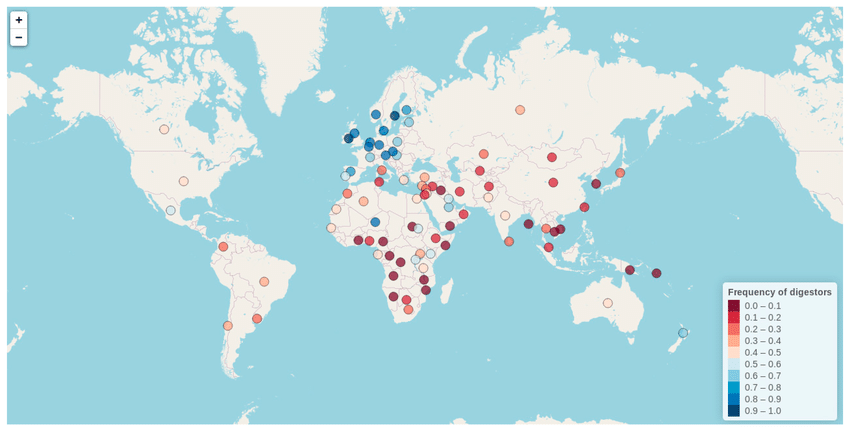Across the world, a few human traits tell a remarkable story of how genes, culture, and environment have co-evolved. Two of the clearest examples are lactase persistence (the ability to digest milk sugar as adults) and light skin pigmentation. Both reflect strong natural selection linked to diet and sunlight exposure — and both trace their spread through ancient human migrations.
The Lactose Story: How Milk Changed Human Evolution
For most mammals, the gene controlling the digestion of milk sugar (lactose) switches off after weaning. Yet in some human populations, that gene stayed active — a mutation near LCT/MCM6 allows adults to keep producing lactase, the enzyme that breaks down milk sugar. This trait, called lactase persistence (LP), became highly advantageous wherever dairy farming developed.
In prehistoric Europe, the allele responsible for lactase persistence was extremely rare during the Neolithic and even the Bronze Age. It only rose to high frequency in the last 3,000 years, suggesting one of the strongest cases of recent natural selection ever detected. In environments with low sunlight, drinking milk provided not only calories and hydration, but also an additional source of vitamin D and calcium.

Map of lactose tolerance frequencies worldwide. Note the highest frequencies in northwest Europe, and parallel peaks in pastoralist regions of Africa and the Middle East.
Light Skin and Low Sunlight: Another Adaptive Trait
In parallel, several genes related to skin pigmentation — especially SLC24A5, SLC45A2, and HERC2/OCA2 — underwent rapid selection in northern latitudes. Light skin allows more efficient synthesis of vitamin D under low ultraviolet (UV) radiation, an essential adaptation as humans migrated away from the tropics.
The combination of light skin and lactase persistence forms a perfect example of human adaptation to new ecological pressures. Both traits improved survival and fertility in regions with low sunlight and cold climates.
The Corded Ware Connection: Migration and Selection
Ancient DNA studies show that many populations of the European Bronze Age carried substantial ancestry from the Steppe or Corded Ware horizon. These groups brought new genetic components — including those linked to Indo-European languages — and likely spread the cultural practice of dairying.
Interestingly, the lactase persistence mutation itself was not yet common among these migrants. Its later success was the result of natural selection acting on a gene–culture combination: people who drank milk and lived in low-UV regions survived and reproduced better. Thus, while Corded Ware ancestry correlates with lactose tolerance today, it was natural selection after migration that amplified the genetic trait.
Culture, Genes, and Environment Working Together
The story of milk and skin color reminds us that evolution didn’t stop in prehistory. It continued — and still continues — wherever human populations faced new diets, climates, or lifestyles. In Africa, for example, pastoralist groups evolved different genetic solutions for the same lactase-persistence phenotype, showing that culture and biology co-evolve.
Conclusion
By tracing these adaptive traits through genetics, archaeology, and anthropology, we can literally see natural selection at work in our own species. Each mutation, each migration, and each cultural shift has left its mark on who we are today.
References:
ScienceDirect (2020) –Human Genetics: Lactase Persistence in a Battlefield
Nature (2024) – The selection landscape and genetic legacy of ancient Eurasians
PNAS (2025) – Inference of human pigmentation from ancient DNA by genotype likelihoods
Researchgate (2020) – Genetics of Lactose Intolerance: An Updated Review and Online Interactive World Maps of Phenotype and Genotype Frequencies

